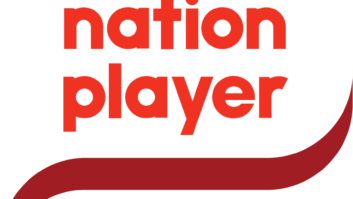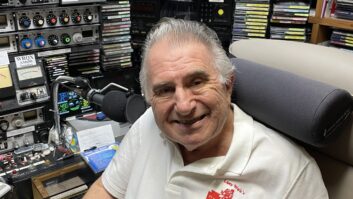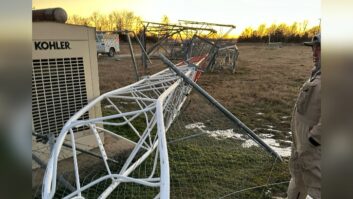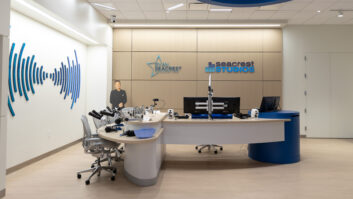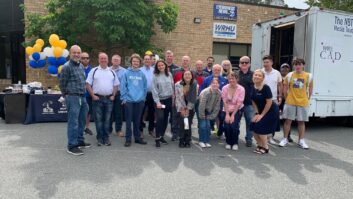JENNiRADIO: For Kids, By Kids
Jan 6, 2013 8:00 AM, By Max Smart
KALY-AM 1240 in Albuquerque, N.M., launched in December 2010 with the youngest radio station owner in the United States. At 14, when she took her JENNiRADIO – For Kids � By Kids music format to air on KALY, Jennifer Smart already had eight years of experience as a nationally syndicated talk show host, first on the Family Tech Show, and then on the Smart Family Show and Online Tonight. Jennifer created the JENNiRADIO music format to reach tweens and teens, and with encouragement from industry veteran David H. Lawrence XVII and Bob Perry, decided to extend the format from its online home to a terrestrial broadcast station of her own.

After a nationwide search, we settled on a former Disney Radio station in Albuquerque, which offered the benefit of a good market rank (#68) and convenient access to Los Angeles, where Jennifer does a lot of red carpet interviews with celebrities. Because the station had been dark for 10 months, we faced some challenges in getting it up and running again. Nevertheless, we bought it during the fall 2010, integrated the Disney equipment we had acquired with our own equipment, secured FCC approval by December, and finished up just two minutes shy of our Dec. 18 on-air deadline for JENNiRADIO.
The facilities
We didn”t acquire a studio facility along with the station purchase, so we went with what we had: a hut standing in the middle of a field in northern Albuquerque. With some help from independent engineers, I built a station that would support not only Jennifer”s production and broadcast work, but that of the Jennifer Smart Foundation”s Find Your Voice program, which gives a voice to local kids by putting them on the air.
In the studio Jennifer uses E-V RE-20 mics, as well as Sennheiser MK4 studio condenser mics, along with a Behringer Powerplay Pro headphone amp. We have used PreSonus VXP voice processors for a long time, largely because we felt they dealt very well with the sing-songy quality of kids” voices and the extremes of quiet and loud we get while recording them. The processors don”t have automatic gain control, but they have a de-esser, compressor, equalizer, limiter and expander, so we have been able get the levels and control we needed, and to keep Jennifer”s voice relatively level. We still love them today, though they”re no longer made. She has used them since the beginning, and we still have four or five that, eventually, we”ll need to replace.
We use iMediaTouch for automation, and it has worked well for us. Like the PreSonus units, this is a tool we”ve worked with for nearly a decade. We originally learned about it through David Lawrence, and we saw it in action at CNET, which used iMediaTouch for a San Francisco Bay Area radio station it ran in the 2000s. I had friends working there, so once we got into the broadcast business ourselves, we knew that we”d have people who could give us a hand with the system. Being computer people, we also liked the look of it and thought it would look great with our studio decor.
– continued on page 2
JENNiRADIO: For Kids, By Kids
Jan 6, 2013 8:00 AM, By Max Smart
Most labels are giving us AAC-encoded music now, and it doesn”t make sense to go from compressed to decompressed and back. It”s just too lossy, so we”ll look for AAC support in iMediaTouch and other automation systems when the time comes to upgrade. We”d also like to take advantage of auto-ducking, not just because Jennifer does a lot of voice tracks, but also because visiting kids” voices can get lost when laid over a heavy song intro.

The air studio
For a while we used the console that came with our Radio Disney purchase, but we quickly outgrew it and moved up to a 12-fader Audioarts Air-3 board. What we missed, however, were the inbound monitoring capabilities: the ability to monitor the production before the delay, after the delay, and the air feed. To accommodate the Air-3”s single monitor input, we added a switch for all the monitoring.
When we installed the Air-3, all the inputs were RJ-45. With my background in computer science and networking, I”m not always familiar with conventional audio routes and wiring, but I can Ethernet all day long. In fact, the evolution of broadcast standards to a foundation of CAT5 networking made the facility build fairly straightforward. The studio depends on CAT5 cable and RJ-45 connectors. As all the cables hub into the Air-3, rewiring is much easier.
The equipment
We use an Eventide BD500 delay and a Digital Alert Systems EAS. Most of the equipment we got from Disney was in immaculate condition, even though some had been around a long time, but one thing we needed to upgrade was the EAS. We moved from an older unit, which had paper jams and illegible printouts, as well as incompatibility with changing government standards. We opted for a four-channel DASDEC-II radio encoder/decoder, which let us replace everything, including the external receivers, because it has integrated radios. Now, even if government requirements are a moving target, we can upgrade our EAS through a simple software update. That”s what really attracted us to Digital Alert Systems and the DASDEC system. The ability to log in from anywhere on my iPad or iPhone to see what messages we received and to send the weekly test has an amazing benefit, especially with travel taking us away from the station so often.

The Nautel transmitter was part of the station”s equipment inventory.
Outgoing signals are fed through an Orban Optimod-AM 9200 digital audio processor and delivered to a 1kW Nautel ND1 AM transmitter. Though Disney had installed a Jazz 1000 for HD Radio, we went analog-only because we just liked the sound better. We generate all of our own programming right now, so we really don”t use the dish and receiver we acquired from Disney. However, for a short time we carried nationally syndicated programming for overnights, and during that time we used an XDS receiver and our existing automation to control our satellite switching.
For our remote broadcasts, we tried one of the main IT transport companies and its inexpensive box, but we just could not get it to sound right for us. So, instead we bought two Mac mini systems, taking one with us and leaving the other (back in Albuquerque), set to auto-answer. We run the systems” audio chat, the Mac minis negotiate the �call,� and the local system puts us on the air. This way we get better quality and more reliable operation than we achieved with other products that cost twice as much. We aren”t using it 24/7, so it meets our needs well. For regular remotes with one or two people, we did look at Skype and iPhone/iPad clients, but we have a small staff, and the Mac mini auto-answer solution is sufficient�and simple, once it”s set up the first time.
– continued on page 3
JENNiRADIO: For Kids, By Kids
Jan 6, 2013 8:00 AM, By Max Smart

The transmitter building and the (now) unused satellite dish.
The studio we put together is relatively simple, yet it has helped Jennifer not only to meet the demand for tween/teen music and celebrity interviews, but also to raise the profile of her �Find Your Voice� program, which gives kids the chance to improve their communication skills and self-esteem by sharing their stories on the air. We plan to build on this success and expand the program through the construction of another studio in the Los Angeles area.

The PreSonus VXP voice processors
Equipment List
Audioarts Air-3
Behringer Powerplay Pro
Digital Alert Systems DASDEC-II
E-V RE-20
Eventide BD500
iMediaTouch
Mac mini
Nautel ND1
Orban Optimod-AM 9200
PreSonus VXP
Sennheiser MK4
Smart is the talent/technology manager for JenniRadio.
January 2013
The studios of JENNiRADIO, making HD Radio more than just a jukebox, testing antennas with a network analyzer, and Field Reports on the Tieline Report-IT and Deva Broadcast SmartGen Mini….






